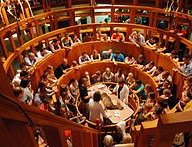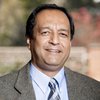
The University of Uppsala in Sweden is renowned for its excellence in academia, but historically the most fascinating part of the University is where human anatomical dissections were carried out in the middle ages. Imagine going to watch a dissection of a human corpse in a small amphitheater( pic) as an after- dinner event. But this is exactly what the nobility of Uppsala did at that time. The Church allowed only people who were executed by the hangman to be dissected. And the prisoners who were being executed were all too happy to be dissected after death because unlike others who were met the same fate by the hangman, the prisoners who were dissected for anatomy received a proper Christian burial, something the prisoners desperately desired. However witnessing human dissection was not for the faint of heart.
Although the dissection was carried out chiefly for the sake of the medical students, the Uppsala nobility also showed up to watch the dissection. It was the thing to do. There was no embalming then, so the stench in the dissection hall was like a physical blow. Many handy supports were people could hold on to if they felt faint were built, and the wall of the ampitheater was painted a reddish colour( and not white) so that stains caused by people being sick would be less prominent.
The amphitheater( also called the cupola) with a magnificent dome is preserved today in a beautiful museum called the Gustavianum next to the world famous cathedral of Uppsala. But who was the famous doctor from Uppsala who started dissection in this cupola?
It was none other than Olaf Rudbeck who returned from Leiden, Holland around the 1650s after receiving an excellent training in human dissection there. He wanted a similar dissection setup so that medical students in his town would have the same learning experience as in Holland.Rudbeck worked hard and paid close attention to detail as he dissected away on the corpses of these prisoners. And his hard work paid off. He was able to discover the lymphatic system in the human body which until this time had not been known to exist. He presented his findings to Queen Christina of Sweden in the spring of 1652, and she was suitably impressed and helped him in his career.
In terms of intellectual content several other famous physicians from Uppsala besides Rudbeck have bequeathed generously to the world of medicine.
Carl Linnaeus physician and botanist from Uppsala laid the foundations for the modern biological naming scheme in botany. He is known as the father of modern taxonomy in botany which is a way of classifying plants. Linnaeus’s classification was a challenge to memorize in pre- medicine training.
But in the present era,a very important person in medicine from Uppsala is surely Otto Cars who has devoted almost his entire career on research about antibiotic resistance ( ABR). Only now the world may be listening to himas GAP ( Global Action Plan) for dealing with antibiotic resistance has only some weeks ago been presented by the WHO. Long before the alarming World Health Organization report on ABR came out, Otto Cars in his self-effacing manner was always making sure to remind the world of the potential threat of ABR.
The nearbyKarolinksaInstitute in Stockholm associated with the Nobel prize in medicine may be better known, but clearly some ground- breaking medical work has been carried out inUppsala fromRudbeckto Linnaeus to Otto Cars. Dag Hammarskjold the renowned UN secretary general and another denizen of Uppsala, who died in a plane crash in 1961, would for sure completely agree.

Buddha Basnyat MD
Buddha Basnyat, MD, MSc, FACP, FRCP, Director of the Oxford University Clinical Research Unit-Patan Academy of Health Sciences, Kathmandu.
- Altitude Sickness
- Feb 20, 2018
- Post-earthquake Nepal: The Way Forward
- Dec 13, 2015
- The Annapurna Sanctuary
- Nov 29, 2015
- Diarrhea at the Summit
- Nov 08, 2015
- Altitude Sickness ( AMS, HAPE, HACE)
- Oct 15, 2015
















